Forest Disturbances and Regrowth Assessment Using ALOS PALSAR Data from 2007 to 2010 in Vietnam, Cambodia and Lao PDR
Abstract
:1. Introduction
2. Study Sites and Data
2.1. Study Sites
2.2. Remote Sensing Data
2.3. The Training and Testing Database
3. Forest Disturbances and Regrowth Detection Method
3.1. ALOS PALSAR Mosaic Generation and Pre-Processing
3.2. Masking Undesirable Areas
3.3. Forest Disturbances and Regrowth Detection Indicators
3.4. The EM Algorithm
3.5. The Forest Disturbances and Regrowth Detection Algorithm
- The pixel was not masked by the procedure described in Section 3.2;
- The condition in Equation (12) is fulfilled;
- dB before the forest disturbance event and dB after the forest disturbance event for forest disturbance class; and
- dB before the forest regrowth event and dB after the forest regrowth event for the forest regrowth class.
3.6. Uncertainties Assessment
3.6.1. Uncertainties Related to Areas of Forest Disturbance
3.6.2. Uncertainties Related to Carbon Emission Estimates
3.6.3. Propagation of Uncertainties
4. Results and Discussion
4.1. Characteristics of Backscatter for Natural Forest, Disturbed and Regrowth Areas
4.2. Masking Undesirable Areas
4.3. Forest Disturbances and Regrowth Assessment
4.4. Validation
5. Conclusions
Acknowledgments
Author Contributions
Conflicts of Interest
References
- Harris, N.L.; Brown, S.; Hagen, S.C.; Saatchi, S.S.; Petrova, S.; Salas, W.; Hansen, M.C.; Potapov, P.V.; Lotsch, A. Baseline map of carbon emissions from deforestation in tropical regions. Science 2012, 336, 1573–1576. [Google Scholar] [CrossRef] [PubMed]
- Lewis, S.; Lopez-Gonzalez, G.; Sonké, B.; Affum-Baffoe, K.; Baker, T.; Ojo, L.; Phillips, O.; Reitsma, J.; White, L.; Comiskey, J.; et al. Increasing carbon storage in intact African tropical forests. Nature 2009, 457, 1003–1006. [Google Scholar] [CrossRef] [PubMed]
- Whittle, M.; Quegan, S.; Uryu, Y.; Stüewe, M.; Yulianto, K. Detection of tropical deforestation using ALOS-PALSAR: A sumatran case study. Remote Sens. Environ. 2012, 124, 83–98. [Google Scholar] [CrossRef]
- Van der Werf, G.R.; Morton, D.C.; DeFries, R.S.; Olivier, J.G.; Kasibhatla, P.S.; Jackson, R.B.; Collatz, G.J.; Randerson, J. CO2 emissions from forest loss. Nat. Geosci. 2009, 2, 737–738. [Google Scholar] [CrossRef]
- FAO. Global Forest Resources Assessment; Technical Report; Food and Agriculture Association of the United-States: Rome, Italy, 2010. [Google Scholar]
- Kennedy, R.E.; Yang, Z.; Cohen, W.B. Detecting trends in forest disturbance and recovery using yearly Landsat time series: 1. LandTrendr—Temporal segmentation algorithms. Remote Sens. Environ. 2010, 114, 2897–2910. [Google Scholar] [CrossRef]
- Cohen, W.B.; Yang, Z.; Kennedy, R. Detecting trends in forest disturbance and recovery using yearly Landsat time series: 2. TimeSync—Tools for calibration and validation. Remote Sens. Environ. 2010, 114, 2911–2924. [Google Scholar] [CrossRef]
- Zhu, Z.; Woodcock, C.E. Continuous change detection and classification of land cover using all available Landsat data. Remote Sens. Environ. 2014, 144, 152–171. [Google Scholar] [CrossRef]
- Hansen, M.; Potapov, P.; Moore, R.; Hancher, M.; Turubanova, S.; Tyukavina, A.; Thau, D.; Stehman, S.; Goetz, S.; Loveland, T.; et al. High-resolution global maps of 21st-century forest cover change. Science 2013, 342, 850–853. [Google Scholar] [CrossRef] [PubMed]
- Sannier, C.; McRoberts, R.E.; Fichet, L.V. Suitability of global forest change data to report forest cover estimates at national level in Gabon. Remote Sens. Environ. 2015, 173, 326–338. [Google Scholar] [CrossRef]
- Holmgren, P. Can we trust country-level data from global forest assessments? For. News. 2015. Available online: http://blog.cifor.org/34669/ (accessed on 1 December 2015).
- Le Toan, T.; Beaudoin, A.; Riom, J.; Guyon, D. Relating forest biomass to SAR data. Geosci. Remote Sens. IEEE Trans. 1992, 30, 403–411. [Google Scholar] [CrossRef]
- Le Toan, T.; Quegan, S.; Woodward, I.; Lomas, M.; Delbart, N.; Picard, G. Relating radar remote sensing of biomass to modelling of forest carbon budgets. Clim. Chang. 2004, 67, 379–402. [Google Scholar] [CrossRef]
- Mermoz, S.; Réjou-Méchain, M.; Villard, L.; Le Toan, T.; Rossi, V.; Gourlet-Fleury, S. Decrease of L-band SAR backscatter with biomass of dense forests. Remote Sens. Environ. 2015, 159, 307–317. [Google Scholar] [CrossRef]
- Santos, J.; Lacruz, M.; Araujo, L.; Keil, M. Savanna and tropical rainforest biomass estimation and spatialization using JERS-1 data. Int. J. Remote Sens. 2002, 23, 1217–1229. [Google Scholar] [CrossRef]
- Santoro, M. Estimation of Biophysical Parameters in Boreal Forests from ERS and JERS SAR Interferometry. Ph.D. Thesis, Department of Radio and Space Science, Chalmers University of Technology, GÃ˝uteborg, Sweden, 2003. [Google Scholar]
- Saatchi, S.; Marlier, M.; Chazdon, R.; Clark, D.; Russell, A. Impact of spatial variability of tropical forest structure on radar estimation of aboveground biomass. Remote Sens. Environ. 2011, 115, 2836–2849. [Google Scholar] [CrossRef]
- Cartus, O.; Santoro, M.; Kellndorfer, J. Mapping forest aboveground biomass in the Northeastern United States with ALOS PALSAR dual polarization L-band. Remote Sens. Environ. 2012, 124, 466–478. [Google Scholar] [CrossRef]
- Carreiras, J.; Melo, J.B.; Vasconcelos, M.J. Estimating the above-ground biomass in Miombo Savanna woodlands (Mozambique, East Africa) using L-band synthetic aperture radar data. Remote Sens. 2013, 5, 1524–1548. [Google Scholar] [CrossRef]
- Mermoz, S.; Le Toan, T.; Villard, L.; Réjou-Méchain, M.; Seifert-Granzin, J. Biomass assessment in the Cameroon savanna using ALOS PALSAR data. Remote Sens. Environ. 2014, 155, 109–119. [Google Scholar] [CrossRef]
- Shimada, M.; Itoh, T.; Motooka, T.; Watanabe, M.; Shiraishi, T.; Thapa, R.; Lucas, R. New global forest/non-forest maps from ALOS PALSAR data (2007–2010). Remote Sens. Environ. 2014. [Google Scholar] [CrossRef]
- Achard, F.; Eva, H.; Stibig, H.; Mayaux, P.; Gallego, J.; Richards, T.; Malingreau, J. Determination of deforestation rates of the world’s humid tropical forests. Science 2002, 297, 999–1002. [Google Scholar] [CrossRef] [PubMed]
- Stibig, H.; Achard, F.; Carboni, S.; Raši, R.; Miettinen, J. Change in tropical forest cover of Southeast Asia from 1990 to 2010. Biogeosciences 2014, 11, 247–258. [Google Scholar] [CrossRef] [Green Version]
- Liao, C.; Luo, Y.; Fang, C.; Li, B. Ecosystem carbon stock influenced by plantation practice: implications for planting forests as a measure of climate change mitigation. PLoS ONE 2010, 5, e10867. [Google Scholar] [CrossRef] [PubMed]
- Nizami, S.M.; Yiping, Z.; Liqing, S.; Zhao, W.; Zhang, X. Managing carbon sinks in rubber (Hevea brasilensis) plantation by changing rotation length in SW China. PLoS ONE 2014, 9, e115234. [Google Scholar] [CrossRef] [PubMed]
- Witness, G. Rubber barons. In How Vietnamese Companies and International Financers are Driving a Land Grabbing Crisis in Cambodia and Laos. London; Global Witness Limited: London, UK, 2013. [Google Scholar]
- Moser, G.; Serpico, S.; Vernazza, G. Unsupervised change detection from multichannel SAR images. Geosci. Remote Sens. Lett. IEEE 2007, 4, 278–282. [Google Scholar] [CrossRef]
- Bazi, Y.; Melgani, F.; Bruzzone, L.; Vernazza, G. A genetic expectation-maximization method for unsupervised change detection in multitemporal SAR imagery. Int. J. Remote Sens. 2009, 30, 6591–6610. [Google Scholar] [CrossRef]
- Reigber, A.; Jäger, M.; Neumann, M.; Ferro-Famil, L. Classifying polarimetric SAR data by combining expectation methods with spatial context. Int. J. Remote Sens. 2010, 31, 727–744. [Google Scholar] [CrossRef]
- Shimada, M.; Isoguchi, O.; Tadono, T.; Isono, K. PALSAR radiometric and geometric calibration. Geosci. Remote Sens. IEEE Trans. 2009, 47, 3915–3932. [Google Scholar] [CrossRef]
- Google. Google Earth 7; Google Inc.: Mountain View, CA, USA, 2011. [Google Scholar]
- Dorais, A.; Cardille, J. Strategies for incorporating high-resolution google earth databases to guide and validate classifications: Understanding deforestation in Borneo. Remote Sens. 2011, 3, 1157–1176. [Google Scholar] [CrossRef]
- Radke, R.J.; Andra, S.; Al-Kofahi, O.; Roysam, B. Image change detection algorithms: A systematic survey. Image Proc. IEEE Trans. 2005, 14, 294–307. [Google Scholar] [CrossRef]
- Shimada, M.; Ohtaki, T. Generating large-scale high-quality SAR mosaic datasets: Application to PALSAR data for global monitoring. Geosci. Remote Sens. IEEE Trans. 2010, 3, 637–656. [Google Scholar] [CrossRef]
- Bruniquel, J.; Lopes, A. Multi-variate optimal speckle reduction in SAR imagery. Int. J. Remote Sens. 1997, 18, 603–627. [Google Scholar] [CrossRef]
- Quegan, S.; Yu, J. Filtering of multichannel SAR images. Geosci. Remote Sens. IEEE Trans. 2001, 39, 2373–2379. [Google Scholar] [CrossRef]
- Motohka, T.; Shimada, M.; Uryu, Y.; Setiabudi, B. Using time series PALSAR gamma nought mosaics for automatic detection of tropical deforestation: A test study in Riau, Indonesia. Remote Sens. Environ. 2014, 155, 79–88. [Google Scholar] [CrossRef]
- Du, Y.; Cihlar, J.; Beaubien, J.; Latifovic, R. Radiometric normalization, compositing, and quality control for satellite high resolution image mosaics over large areas. Geosc. Remote Sens. IEEE Trans. 2001, 39, 623–634. [Google Scholar]
- Giri, C.; Ochieng, E.; Tieszen, L.; Zhu, Z.; Singh, A.; Loveland, T.; Masek, J.; Duke, N. Status and distribution of mangrove forests of the world using earth observation satellite data. Glob. Ecol. Biogeogr. 2011, 20, 154–159. [Google Scholar] [CrossRef]
- Danko, D.M. The digital chart of the world project. Photogramm. Eng. Remote Sens. 1992, 58, 1125–1128. [Google Scholar]
- Sexton, J.O.; Song, X.P.; Feng, M.; Noojipady, P.; Anand, A.; Huang, C.; Kim, D.H.; Collins, K.M.; Channan, S.; DiMiceli, C.; et al. Global, 30-m resolution continuous fields of tree cover: Landsat-based rescaling of MODIS vegetation continuous fields with lidar-based estimates of error. Int. J. Digit. Earth 2013, 6, 427–448. [Google Scholar] [CrossRef]
- Bontemps, S.; Defourny, P.; Van Bogaert, E.; Arino, O.; Kalogirou, V.; Ramos Perez, J. GlobCover 2009: Products Description and Validation Report. 2011, Volume 2. Available online: http://ionia1.esrin.esa. int/docs/GLOBCOVER2009_Validation_Report_2 (accessed on 1 December 2015).
- Bujor, F.; Trouvé, E.; Valet, L.; Nicolas, J.M.; Rudant, J.P. Application of log-cumulants to the detection of spatiotemporal discontinuities in multitemporal SAR images. Geosci. Remote Sens. IEEE Trans. 2004, 42, 2073–2084. [Google Scholar] [CrossRef]
- Inglada, J.; Mercier, G. A new statistical similarity measure for change detection in multitemporal SAR images and its extension to multiscale change analysis. Geosci. Remote Sens. IEEE Trans. 2007, 45, 1432–1445. [Google Scholar] [CrossRef]
- Santoro, M.; Fransson, J.E.; Eriksson, L.E.; Ulander, L.M. Clear-cut detection in Swedish boreal forest using multi-temporal ALOS PALSAR backscatter data. Sel. Top. Appl. Earth Obs. Remote Sens. IEEE J. 2010, 3, 618–631. [Google Scholar] [CrossRef]
- Joshi, N. P.; Mitchard, E. T.; Schumacher, J.; Johannsen, V.K.; Saatchi, S.; Fensholt, R. L-band SAR backscatter related to forest cover, height and aboveground biomass at multiple spatial scales across Denmark. Remote Sens. 2015, 7, 4442–4472. [Google Scholar] [CrossRef]
- Zadeh, L.A. Fuzzy logic and approximate reasoning. Synthese 1975, 30, 407–428. [Google Scholar] [CrossRef]
- Bezdek, J.C. Pattern Recognition with Fuzzy Objective Function Algorithms; Plenum press: New York, NY, United States, 1981. [Google Scholar]
- Du, L.; Lee, J. Fuzzy classification of earth terrain covers using complex polarimetric SAR data. Int. J. Remote Sens. 1996, 17, 809–826. [Google Scholar] [CrossRef]
- Puyravaud, J.P. Standardizing the calculation of the annual rate of deforestation. For. Ecol. Manag. 2003, 177, 593–596. [Google Scholar] [CrossRef]
- Olofsson, P.; Foody, G.M.; Stehman, S.V.; Woodcock, C.E. Making better use of accuracy data in land change studies: Estimating accuracy and area and quantifying uncertainty using stratified estimation. Remote Sens. Environ. 2013, 129, 122–131. [Google Scholar] [CrossRef]
- Cochran, W.G. Sampling Techniquess; Wiley: New York, NY, USA, 1977. [Google Scholar]
- Saatchi, S.S.; Harris, N.L.; Brown, S.; Lefsky, M.; Mitchard, E.T.; Salas, W.; Zutta, B.R.; Buermann, W.; Lewis, S.L.; Hagen, S.; et al. Benchmark map of forest carbon stocks in tropical regions across three continents. Proc. Natl. Acad. Sci. 2011, 108, 9899–9904. [Google Scholar] [CrossRef] [PubMed]
- Baccini, A.; Goetz, S.; Walker, W.; Laporte, N.; Sun, M.; Sulla-Menashe, D.; Hackler, J.; Beck, P.; Dubayah, R.; Friedl, M.; et al. Estimated carbon dioxide emissions from tropical deforestation improved by carbon-density maps. Nat. Clim. Chang. 2012, 2, 182–185. [Google Scholar] [CrossRef]
- General Statistics Office of Vietnam. Agriculture, Fishery and Fishery Statistical Data. Available online: http://www.gso.gov.vn/ (accessed on 1 December 2015).
- FAO. Global Forest Resources Assessment; Technical Report; Food and Agriculture Association of the United-States: Rome, Italy, 2005. [Google Scholar]
- Iremonger, S.; Gerrand, A.M. Global Ecological Zones Map for FAO FRA 2010; Technical Report; FAO: Rome, Italy, 2011. [Google Scholar]
- Lang, C. The Pulp Invasion: The International Pulp and Paper Industry in the Mekong Region; World Rainforest Movement Montevideo: Moreton-in-Marsh, UK, 2002. [Google Scholar]
- EIA-Telepak. Borderlines: Vietnam’s Booming Furniture Industry and Timber Smuggling in the Mekong Region; Technical Report; Environmental Investigation Agency-Telapak: London, UK, 2008. [Google Scholar]
- Grainger, A. Difficulties in tracking the long-term global trend in tropical forest area. Proc. Natl. Acad. Sci. 2008, 105, 818–823. [Google Scholar] [CrossRef] [PubMed]
- Meyfroidt, P.; Lambin, E.F. Forest transition in Vietnam and displacement of deforestation abroad. Proc. Natl. Acad. Sci. 2009, 106, 16139–16144. [Google Scholar] [CrossRef] [PubMed]
- Bellot, F.; Bertram, M.; Navratil, P.; Siegert, F.; Dotzauer, H. The High Resolution Global Map of 21st Century Forest Cover Change from the University of Maryland is Hugely Overestimating Deforestation in Indonesian; Technical Report; Forests and Climate Change Programme (FORCLIME): Jakarta, Indonesia, 2014. [Google Scholar]
- FAO. Global Forest Resources Assessment; Technical Report; Food and Agriculture Association of the United-States: Rome, Italy, 1995. [Google Scholar]
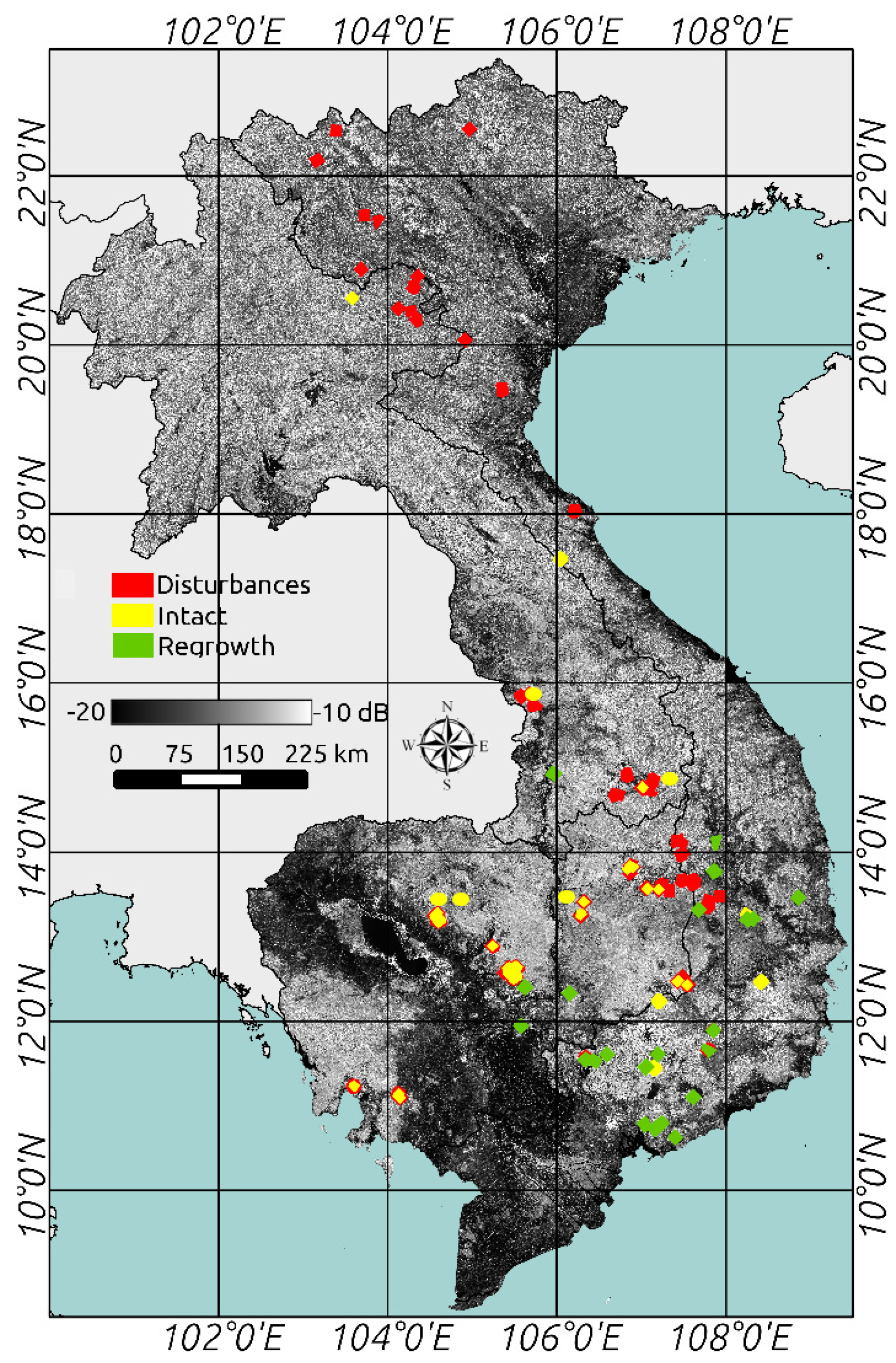

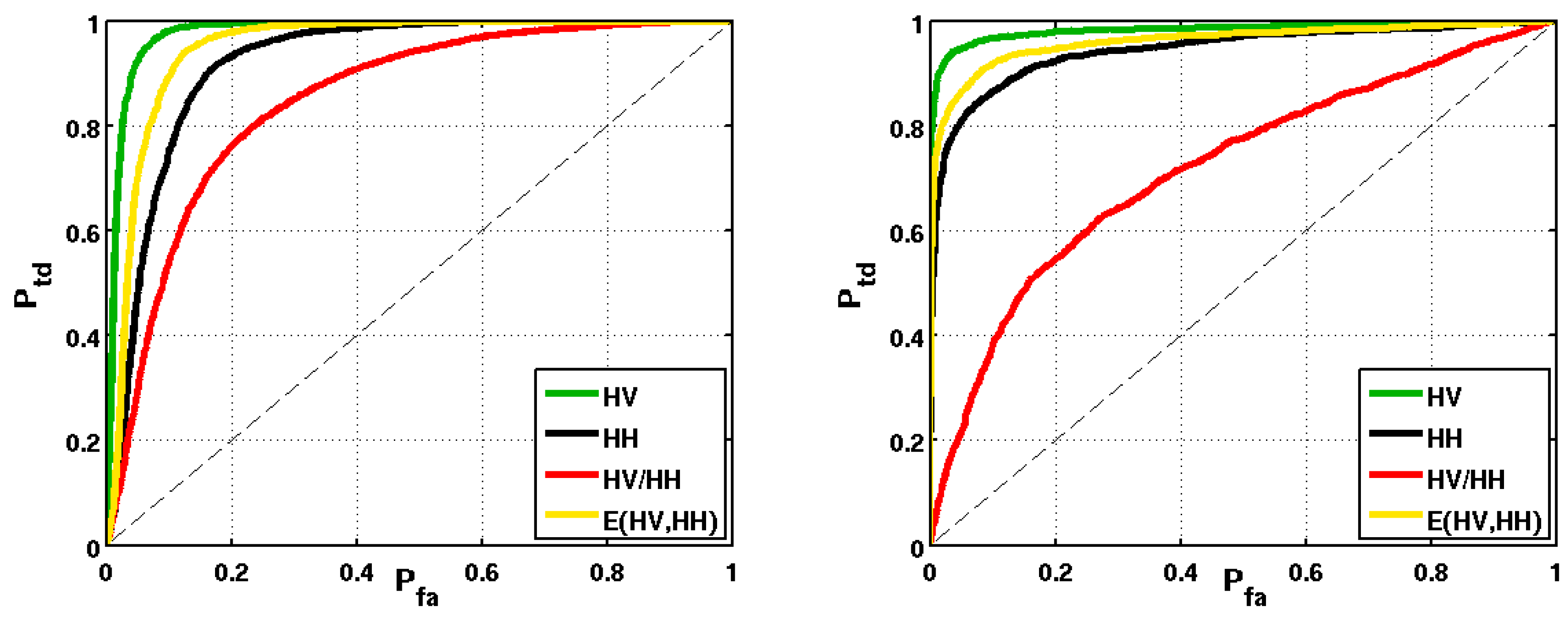
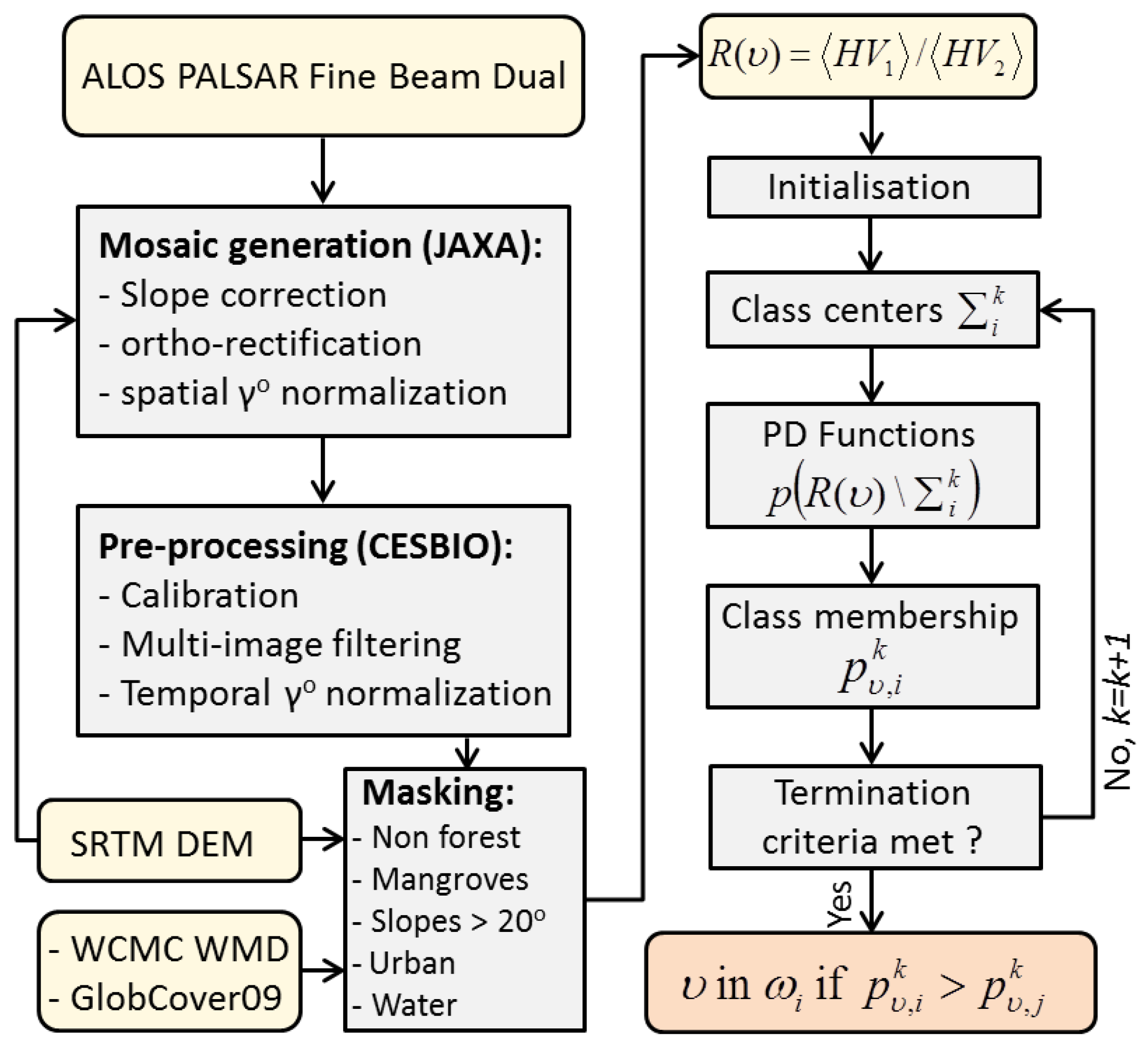


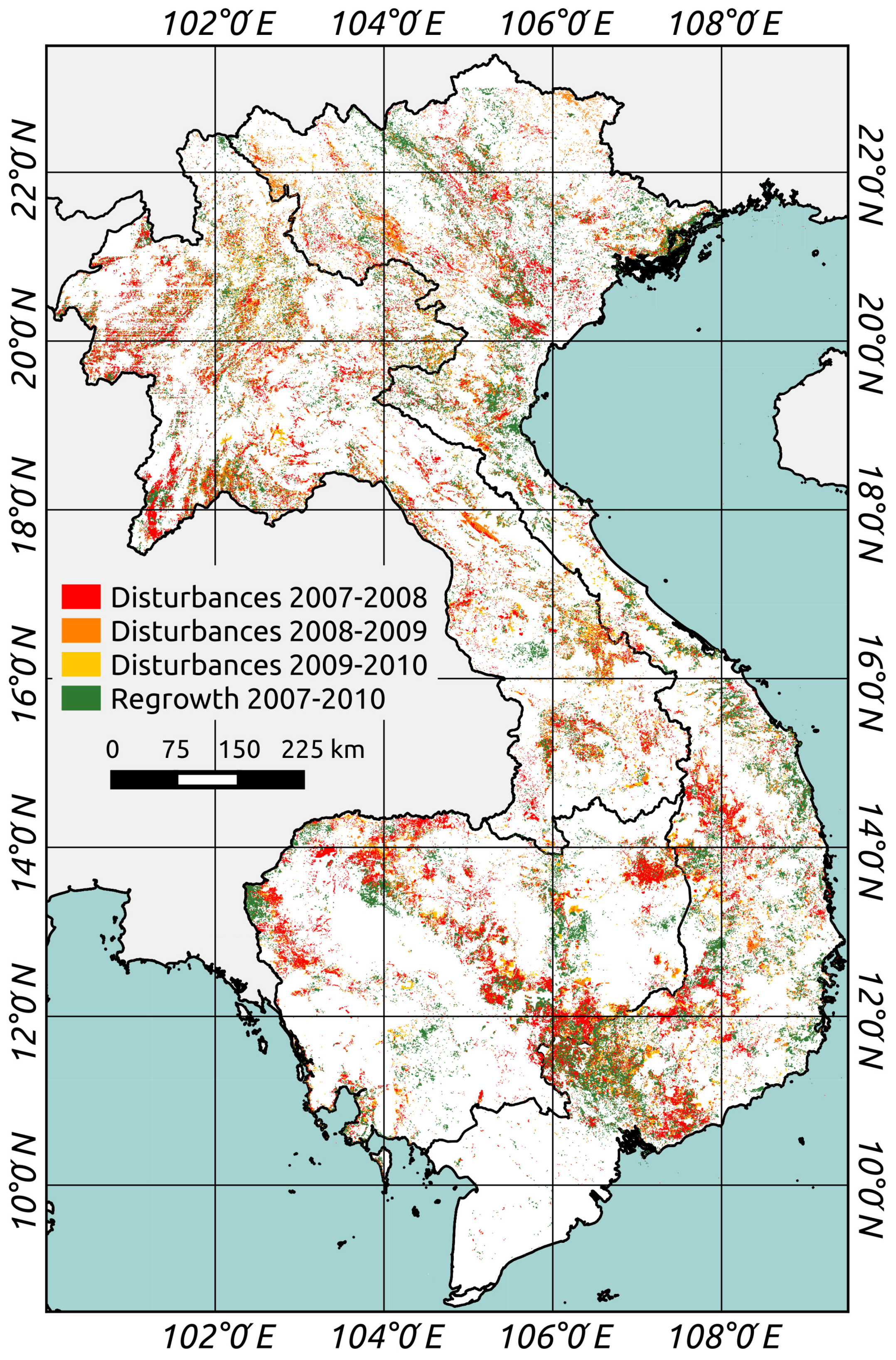
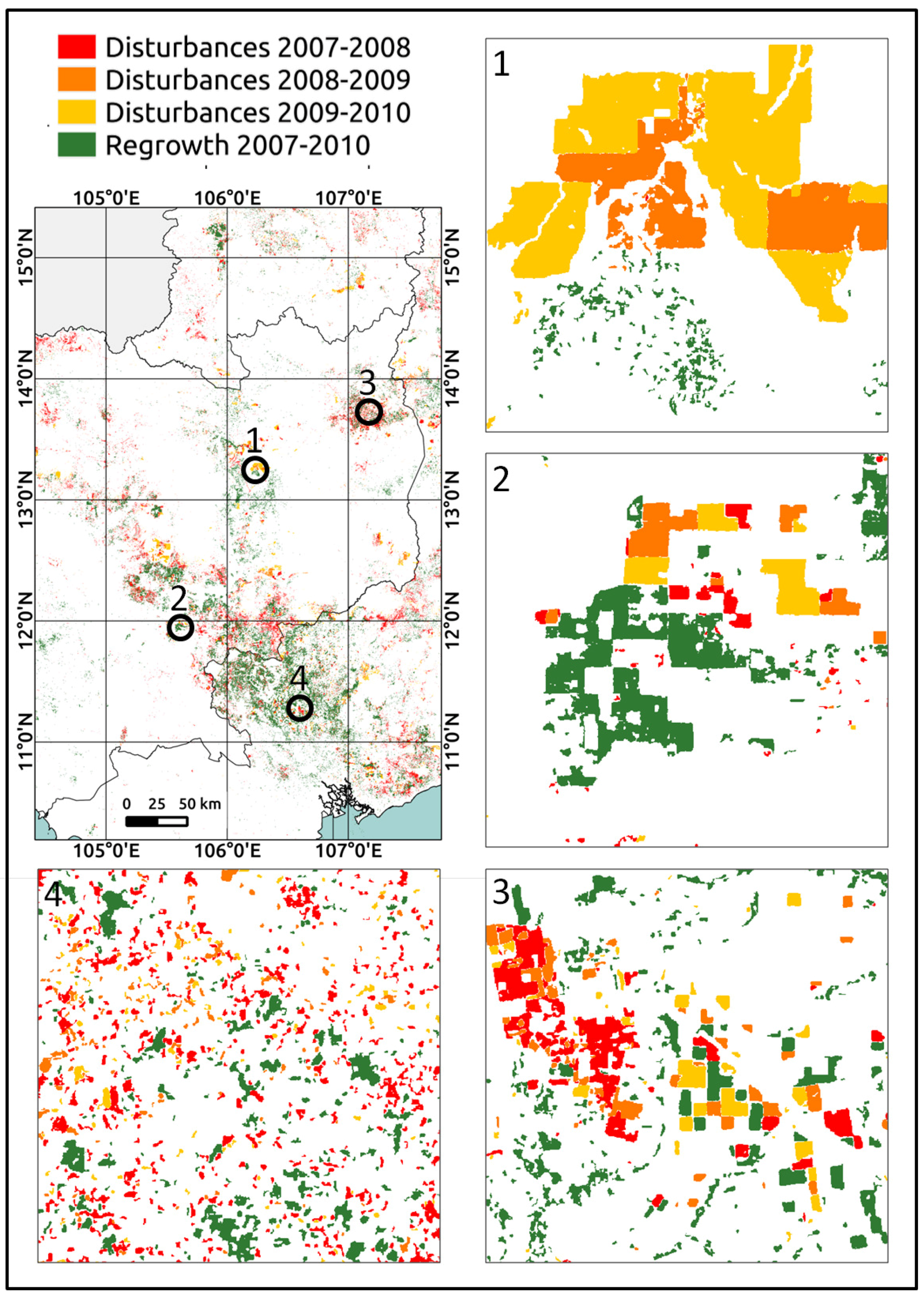
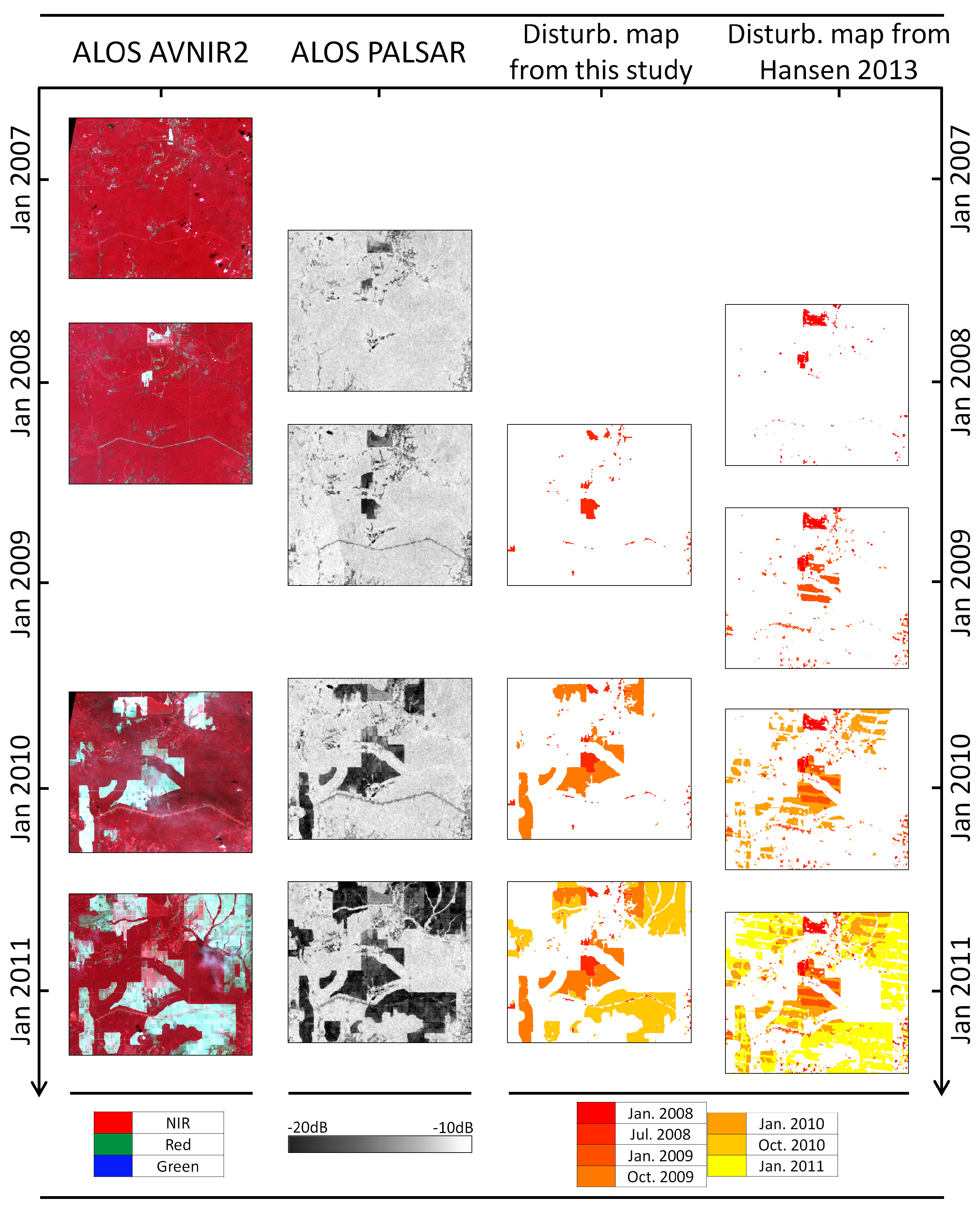
| No. of Areas | Mean Size (ha) | Surface (ha) | |
|---|---|---|---|
| No Disturbances | 59 | 209.1 | 12,333 |
| Disturbances | 86 | 5.3 | 428 |
| Regrowth | 23 | 2.7 | 144 |
| Vietnam | Cambodia | Lao PDR | |
|---|---|---|---|
| Forest (%) | 37.9 | 50.8 | 58.6 |
| Slope >20 (%) | 18.1 | 1.7 | 21.7 |
| Inundated lands (%) | 2.2 | 14.3 | 0.8 |
| Mangroves (%) | 0.4 | 0.3 | 0 |
| Urban (%) | 8.7 | 9.4 | 0.6 |
| Vietnam | Cambodia | Lao PDR | |
|---|---|---|---|
| Disturb.rates (%) | −1.07 | −1.22 | −0.94 |
| This study | |||
| Disturb. rates (%) | −1.16 | −1.58 | −0.96 |
| Hansen | |||
| Regrowth rates (%) | 0.82 | 0.49 | 0.35 |
| This study |
| In situ | |||||||
|---|---|---|---|---|---|---|---|
| Intact | Dist.7-8 | Dist.8-9 | Dist.9-10 | Reg.7-10 | UA (%) | ||
| Classification | Intact | 177,570/0.95 | 195/1.e | 266/1.4.e | 477/2.5.e | 383/2.e | 99.3 |
| Dist.7-8 | 0/0 | 963/1.4.e | 51/7.e | 48/7.e | 0/0 | 90.7 | |
| Dist.8-9 | 9/10.e | 3/0 | 1139/7.7.e | 78/5.e | 0/0 | 92.7 | |
| Dist.9-10 | 19/0 | 3/0 | 6/0 | 2937/6.7.e | 0/0 | 99.1 | |
| Reg.7-10 | 0/0 | 0/0 | 0/0 | 0/0 | 1688/1.6.e | 100 | |
| PA (%) | 100 | 92.8 | 78 | 63.9 | 88.6 | ||
© 2016 by the authors; licensee MDPI, Basel, Switzerland. This article is an open access article distributed under the terms and conditions of the Creative Commons by Attribution (CC-BY) license (http://creativecommons.org/licenses/by/4.0/).
Share and Cite
Mermoz, S.; Le Toan, T. Forest Disturbances and Regrowth Assessment Using ALOS PALSAR Data from 2007 to 2010 in Vietnam, Cambodia and Lao PDR. Remote Sens. 2016, 8, 217. https://doi.org/10.3390/rs8030217
Mermoz S, Le Toan T. Forest Disturbances and Regrowth Assessment Using ALOS PALSAR Data from 2007 to 2010 in Vietnam, Cambodia and Lao PDR. Remote Sensing. 2016; 8(3):217. https://doi.org/10.3390/rs8030217
Chicago/Turabian StyleMermoz, Stéphane, and Thuy Le Toan. 2016. "Forest Disturbances and Regrowth Assessment Using ALOS PALSAR Data from 2007 to 2010 in Vietnam, Cambodia and Lao PDR" Remote Sensing 8, no. 3: 217. https://doi.org/10.3390/rs8030217





